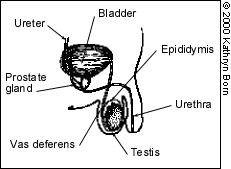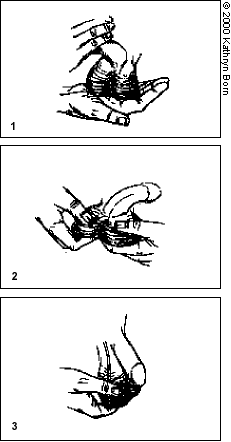D. MJ Bazos MD,
Patient Handout
Testicular
Cancer
What is cancer?
Cancer cells are cells that have mutated
(changed) and grow out of control. They keep on growing and dividing so that too
many cells are produced. These cells clump together to form tumors. If these
tumors are malignant, they can invade and kill your body's healthy tissues. From
these tumors, cancer cells can metastasize (spread) and form new tumors in other
parts of the body. (Tumors that are not cancerous and don't spread are called
"benign tumors.")
 Male reproductive
system Male reproductive
system |
Who gets testicular cancer?
Cancer of the testicles is the most common
cancer in young men (15 to 34 years old). Men who are more likely to get
testicular cancer:
- Are white
- Have a father or brother who had testicular
cancer
- Have a testicle that did not come down into the
scrotum (the skin "sack" that holds the testicles), even if surgery was done to
remove the testicle or bring it down
- Have small testicles or testicles that aren't
shaped normally (most testicles are round, smooth and firm)
- Have Klinefelter's syndrome (a genetic condition)
What are some signs
of testicular cancer?
- A hard, painless lump in the testicle (this is
the most common sign)
- Pain or a dull ache in the scrotum
- A scrotum that feels heavy or swollen
- Bigger or more tender "breasts"
Testicular cancer has a very
good cure rate if it's found early and treated. Your doctor can check your
testicles during an exam. A self-exam is another good way to find testicular
cancer (see below for self-exam directions). If you find anything unusual during
a self-exam (like a lump or swelling), see your doctor right away.
How do I do a testicular
self-exam?
The best time to do the exam is during or right
after a shower or a bath. The warm water relaxes the skin on your scrotum and
makes the exam easier.
- Check your testicles one at a time. Use one or
both hands.
- Cup your scrotum with one hand to see if there is
any change from the way it feels normally (Picture #1).
- Place your index and middle fingers under one
testicle with your thumb on top.
- Gently roll the testicle between your thumb and
fingers.
- Feel for any lumps in or on the side of the
testicle (Picture #2). Repeat with the other testicle.
- Feel along the epididymis (a soft, tubelike,
comma-shaped structure behind the testicle that collects and carries sperm) for
swelling (Picture #3).
It's normal for one testicle to
be a little bit bigger than the other. The testicles should be smooth and firm.
If you feel any bumps or lumps, visit your doctor right away.


